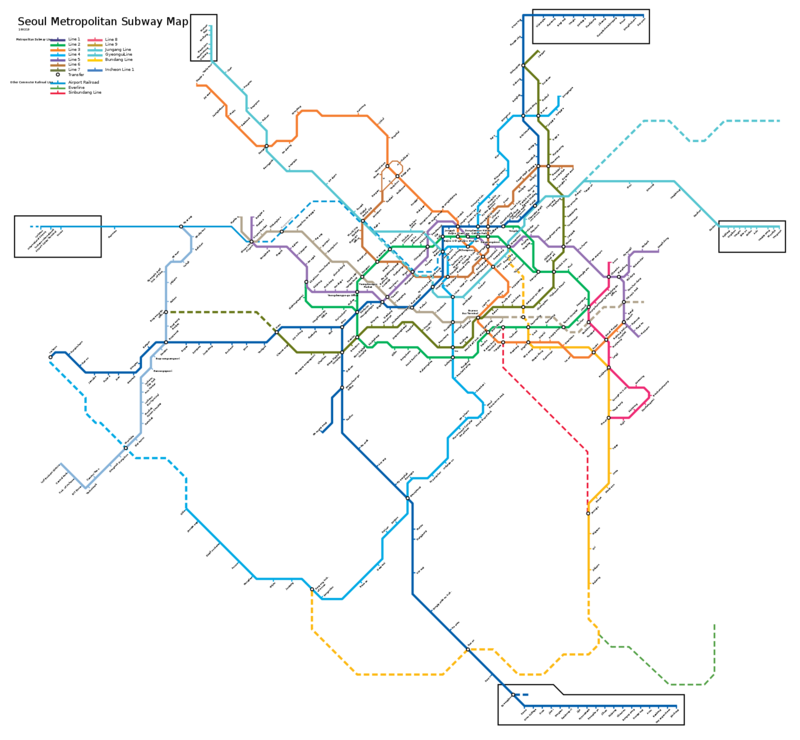The Seoul Metro, which is located in the northeast of South Korea, is a railway service with almost 330 kilometers of total length. It has 9 lines and 300 stations. It is located underground. It travels to most of the regions in the metropolitan area of Seoul, including the Incheon International Airport, all of the cities in the outskirts of the capital, and other cities that belong to the Gyeonggi province. From the total population of 24 million inhabitants in Seoul’s metropolitan area, almost a third of it use the metro. The regular business hours are from 5:30 am to 1:00 am. The price for a regular ticket is 1,350 won (approximately €1).
Metros in South Korea: The Seoul metro
The Seoul Metro started operations on August 15th, 1974, with one line, 9 stations, and a railway length of only 8 kilometers. Its railroad was originally only located between Seoul station and Cheongnyangni station. Nowadays, a little over 40 years later, it has become one of the metro services with the longest railways in the world, with 9 lines and over 300 stations throughout its railway of over 327 kilometers, covering all of the corners of the Seoul metropolitan area. It is used daily by over 7 million people.
Lines and stations
In the Seoul Metro’s network, each city district and their surrounding areas are joined together. The Seoul Metro has 9 lines, covering Seoul, Incheon, the Gyeonggi province, the western part of the Gangwon province, and the northern part of the Chungnam province.
Line 1 or Dark blue
Line 1 started working on August 15th, 1974, with trains driving through the business districts located in downtown Seoul. It is connected to the Gyeongbu, Gyeongin, and Gyeonwon lines from Korail. It is the only line in which the trains drive on the left-hand side of the track. This line begins at Soyosan station. Then, the railroad is divided into branches that lead to the terminal stations of Incheon, Sinchang, Gwangmyeong, and Seodongtan. During this journey, the metro stops at 114 stations. It is marked as dark blue in the maps for the Seoul Metro. This line offers transfers to Incheon city’s metro, where the international airport is located. Incheon’s metro is managed by both Korail and the Seoul Metro. It belongs to both the South Korean government and the city of Seoul.
Line 2 or Light Green
Line 2 was built between the years 1978 and 1984. This line is comprised of the railway between the Seongsu and Sinseol-dong stations. This line connects to downtown Gangnam to the south, the second largest district in Seoul. Afterwards, in 1993, its railway was expanded with the addition of 51 stations between the stations of Sindorim and Kkachisa. It is marked as light green on the metro’s maps. This line is managed by the Seoul Metropolitan Railway Corporation, and belongs to the city of Seoul.
Line 3 or Orange Line
Line 3 was built between the years 1980 and 1993. It is comprised by the stations between the Daehwa and Ogeum stations. It has a total of 44 stations. You will find this line marked in orange on the metro’s maps. It is managed by both Korail and the Seoul Metropolitan Railway Corporation. It belongs to both the South Korean government and the city of Seoul.
Line 4 or Blue Line
Line 4 was built between the years 1980 and 1994. It connects the crowded district northeastern district with the southern part of the city of Seoul. This line is located between the regions of Gwacheon and Ansan, passing through the center of the old city. This line has 51 stations between Dangogae station and Oido station. It is marked in blue on the metro’s maps. This line is managed by both Korail and the Seoul Metropolitan Railway Corporation. It belongs to both the South Korean government and the city of Seoul.
Line 5 or Purple Line
Line 5 was built between the years 1990 and 1996. It connects the eastern region of Seoul with the western region of it. It also offers connections to the Gimpo Airport and the business district of Yeouido. Line 5 is comprised by 51 stations in the railroads between the Banghwa station and the Sangil-dong/Macheon station. It is marked in purple on the metro’s maps. This line is managed by the Seoul Metropolitan Railway Corporation, and it belongs to the city of Seoul.
Line 6 or Brown Line
Line 6’s road is U-shaped, and is located between the Eungam and Bonghwasan stations. It started operations on August, 2000. A brief time afterwards, at the end of that same year, four stations were added to this line’s network. This line was fully finished on the following year, on August 2001. The trains on this line offer transportation to 38 stations. It is marked in brown on the Seoul Metro’s maps. This line is managed by the Seoul Metropolitan Railway Corporation, and it belongs to the city of Seoul.
Line 7 or Olive Green Line
Line 7 was built between the years 1990 and 1996, and it was fully finished on August, 2000. It connects Jangam station with the Konkuk University and the Bupyeong-gu Office without going through downtown Seoul. Currently, this line’s route goes beyond Onsu on western Seoul. It offers service to 51 stations. It is marked in olive green on the Seoul Metro’s maps. This line is managed by the Seoul Metropolitan Railway Corporation, and belongs to the cities of Seoul, Bucheon, and Incheon.
Line 8 or Pink Line
Line 8 was built between the years 1990 and 1999. It is the shortest line of the Seoul Metro. It offers service to the southeastern part of Seoul and to the satellite city of Seongnam, connecting the Amsa station with the Moran station. The trains on this line stop at 17 stations on their journey. It is marked in pink on the Seoul Metro’s maps. This line is managed by the Seoul Metropolitan Railway Corporation, and it belongs to the city of Seoul.
Line 9
Line 9 started working on July 24th, 2009. It connects Gaehwa station with Sports Complex station. In the journey between these two stations, the trains stop at 30 stations. This line is managed jointly by Line 9 Corporation and the Seoul Metro, and it belongs to the city of Seoul, Line 9 Corporation, and the Seoul Metro.
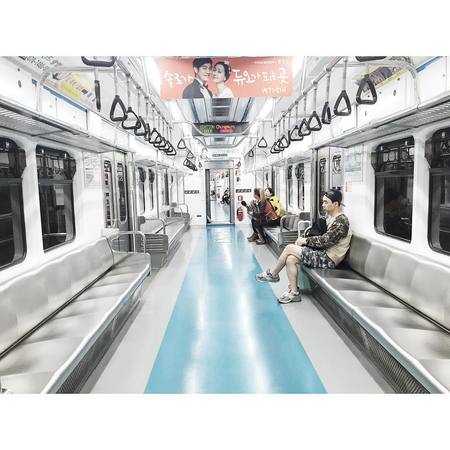
Besides these 9 lines from the Seoul Metro, there are many additional lines (totaling 19) in the city, totaling in 975.4 km (606.1 miles) of railway length. Additionally, the Seoul Metro has the longest railway for a metro system in the world. With 2.5 billion yearly passengers, this is the busiest metro system in the world. It is also ranked second in the world in number of stations for a metro system. It has a total of 607 stations. The metro service in the world with more stations than the Seoul Metro is the New York Metro.
- AREX Line (light blue): Its trains go from Seoul Station to Incheon International Airport. This line has 10 stations, and a railroad length of 58 km. It is managed by the Korail Airport Railroad.
- Jungang Line (turquoise): Its trains go from Yongsan to Yongmun. This line has 28 stations and a railroad length of 71.2 km. It is managed by Korail.
- Gyeongui Line (turquoise): Its trains go from Gongdeok / Seoul Station to Munsan. This line has 23 stations and a railroad length of 50.8 km. It is managed by Korail.
- Gyeongchun Line (turquoise): Its trains go from Sangbong to Chuncheon. This line has a total of 19 stations and a railroad length of 80.7 km. It is managed by Korail.
- Bundang Line (yellow): Its trains go from Wangsimni to Mangpo. This line has 32 stations and a railroad length of 46.8 km. It is managed by Korail.
- Suin Line (yellow): Its trains go from Oido to Songdo. This line has 9 stations and a railroad length of 13.1 km. It is managed by Korail.
- Shinbundang Line (yellow): Its trains go from Gangnam to Jeongja. This line has 6 stations and a railroad length of 17.3 km. It is managed by Neo Trans (DX Line).
- Incheon Line 1 (pastel blue): Its trains go from Gyeyang to the International Business District. This line has 29 stations and a railroad length of 29.4 km. It is managed by Incheon Transit.
- EverLine (green): Its trains travel from Giheung to Jeondae-Everland. This line has 15 stations and a railroad length of 18.1 km. It is managed by Yongin Rapid Transit Corporation.
- U Line (yellow): Its trains travel from Balgok to Tapseok. This line has 15 stations and a railroad length of 11.1 km. It is managed by Uijeongbu LRT Corporation.
The stations are generally two to three minutes away from each other by train. However, some adjacent stations are 15 minutes away from each other by train.
Each station is identified by their name and a 3-digit number. The first digit represents the number of the line. The remaining two digits represent the position of that station with respect to the first station of the line. Besides the number and the name of the station, the name of the following station and the previous station can be read on the platforms, both in English and in Korean.
All stations have maps indicating the exits, the avenues and streets where the trains stop, which exits have escalators or elevators, and even the location of the available restrooms (which, much to tourists’ surprise, are always in pristine conditions).
Another Seoul Metro feature that makes it easy to use is its color coding. The use of a single color for each line, including the trains, stations, cards, and transfer points makes it easy for foreign tourists to find the trains for each line. This is especially useful for tourists who do not speak nor read Korean.
All stations have 4G broadband internet coverage. The signposts and maps are written in Korean, as well as in English. The LCD screens and announcements given within the rail cars give information that is also available in both languages. On the main stations, information is also given in Mandarin Chinese and in Japanese.
The wagons have air conditioning and acclimatized seats that are automatically warmed during winter. Besides, the trains offer an efficient, fast, and safe service. All of these features make the Seoul Metro the best metro service in the Asian continent, as well as one of the best in the world.
With regards of the safety of its passengers, almost all of the stations from the metro have glass walls on the platforms’ edge. Also, the platforms’ doors only open in synchrony with the trains’ doors once they arrive to the platform. These walls, besides protecting the passengers against noise and dust, prevent the area between the platform and the train to become crowded, therefore preventing people from being trapped in a crowd.
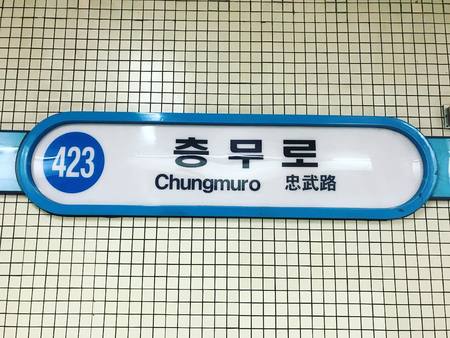 Seoul
Seoul
Schedule, timetables, and calendar
The working hours for the Seoul Metro are from 5:30 am until 1:00 am from Monday to Friday. Meanwhile, during weekends, it operates from 5:30 am until midnight. Its frequency is between four and six minutes during off-peak hours, and between two and three minutes during peak hours.
Ticket, prices, and cards
The Seoul Metro works jointly with the rest of the means of transportation in Seoul. In other words, the metro allows transfers to the other metros in the surrounding suburbs and cities, as well as buses.
The Seoul Metro and the other transportation services in the city share an integrated pricing system: their tickets allow transfers among any means of transportation in Seoul. In other words, tickets allow transfers from the metro to the bus or vice-versa, as well as transfers from bus to bus. These transfers can be made up to five times without any additional fee, except in the case of the Shinbundang line, the U Line, and the Ever line, where an extra fee of 900, 300, and 200 won respectively should be paid.
The transfers should be done within 30 minutes after validating the ticket at the metro’s exit or the bus’s exit (one hour in the case of transfers between 9:00 pm and 7:00 am).
The tickets can be acquired in any of the vending machines found within any station, which accept cash, as well as credit cards. Tickets can also be bought in many kiosks (such as 7-11 stores), which are found in any metro station, as well as throughout the city.
The price of a single ride ticket is 1,350 won (approximately €1), which includes a 500 won deposit that can be refunded at special automatic machines (called Deposit Refund Devices). These machines are located in all of the metro stations.
The 1,250 won fares from the T-money cards give you rides for up to 10 km. If you travel beyond this distance, 100 won will be charged for every additional 5 km travelled. And, if the distance travelled is over 50 km, 100 won will be charged for every additional 8 km travelled.
T-money Cards
Besides the single ride tickets, refillable transportation cards are available. The single ride tickets were made out of magnet sheets until December, 2008, when they were replaced by hard plastic tickets. The cards are known as T-money, and they have dimensions similar to those of a credit card. These cards have RFID technology, which makes them useful for different tasks, such as giving the customer their refund from the deposit made at the time of purchase. These cards can be bought by either debit or credit cards, or by using smartphones with Android operating systems that are capable of supporting the T-money cards. This way of purchasing the T-money card is the most popular way of buying it among South Koreans.
In summary, the T-money cards are essential prepaid transportation cards that can be used until the money loaded in them runs out. They can be refilled to be used once again. However, given their 4,000 won price tag, it may not be worth it to get T-money cards for stays at Seoul that only last one or two days. You would not use the metro enough times to justify the relatively high price.
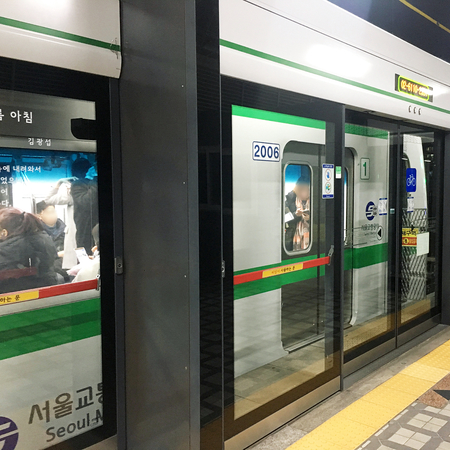
Children fares
In the case of children between 7 and 12 years of age, the fare for the tickets is 450 won. For teenagers between 13 and 18 years of age, the price is 720 won. Finally, people that are 19 and older will be considered adults.
Senior citizens and people with disabilities
For senior citizens and people with disabilities, the entrance is free. They can obtain a free ticket, or they can use the side doors to board and exit the metro, instead of using the turnstiles.
For people that use the metro frequently and for long periods of time, the city’s government offers the monthly card at a price of approximately 48 euros. Some of the prices will be shown below:
- Single ride, for up to 10 km: 1,250 won. An additional 100 won will be charged for every additional 5 km.
- Shinbundang Line Single Ride Ticket: 1,750 won.
- EverLine and U Line Single Ride Ticket: 1,300 won.
- Tickets for Children: they get a 50% discount on their tickets.
- Seniors and People with Disabilities: free.
- Cards available: T-money, Upass, and KB Free Pass.
Tips
The Seoul Metro trains are quite long. Therefore, it would be convenient to check beforehand on the stations’ maps the locations of the exits at your destination. This way, you would know which wagon to board.
It is also important to know the right exit that you should go to at the stations, since there are many exits and the hallways are very long.
Fun facts and tips
Most stations in the Seoul Metro offer lockers that can be used by the passengers and that have text written in different languages. The prices and the time allowed for their use vary depending on the station (usually, they can be used between two to four hours.) The lockers’ fares vary depending on their dimensions: for small lockers, the price is between 1,000 and 2,000 won; for medium lockers, the price is between 1,500 and 3,000 won; and for big lockers, the price is between 2,000 and 4,000 won. The payment methods vary by station, but, in general, payments are possible with the transportation cards (T-money) or with credit cards.
As a fun fact, some stations have vending machines that sell gas masks. The reason for this is quite understandable since, like all metro stations in the world, these stations can be used as shelters in case of terrorist attacks or during war.
Future Expansions
In general, we could say that as the population of Seoul and its surrounding cities grow, the metro service also grows in order to satisfy the increased demand. However, expanding the metro’s lines to offer more transportation in Seoul’s satellite cities would generate an increased demand for transportation in these cities, since there are a large number of potential passengers in them. The number of yearly passengers in the satellite cities of Seoul can be compared with the metro services of big metropoles such as the cities of Tokyo or Moscow.
Therefore, Seoul Metro’s railway has a new line since 2010, which connects Bundang city with the station of Gangnam in approximately 15 minutes. This is the busiest metro station in Seoul (with an average daily ridership of 125,000 passengers during that year). Gangnam station is located in the southern region of the city, where many of the most important businesses in South Korea are located, as well as many entertainment facilities.
Also known as the DX Line, this is the first line for the Seoul Metro that is fully automatic. It is managed by a state-of-the-art train control system, which allows the trains to work without any driver inside them. This control system only requires assistants, which are available for customer support services for the passengers.
Another recently inaugurated line is the refurbished Gyeongchun line, which now offers journeys to Chuncheon, Gangwon-do. The trains of this line drive between the western terminal station of Sangbong in Seoul and the eastern terminal station of Chuncheon in less than 90 minutes.
One of the lines that will be inaugurated on 2017 will be the Ui LRT Line. This line will connect line 4 from the Sungshin Female University with line 6 in Bomun station, and with lines 1 and 2 in Sinseol Dong. It will have 12 stations. It is expected that the Ui LRT Line will have a daily ridership of 110,000 passengers.
Connection to the airport
There are two airports in Seoul: Gimpo International Airport, mainly used for domestic flights, and Incheon International Airport. The easiest to reach Incheon’s airport is via the AREX line, which was inaugurated on 2010. This line joins the Seoul station with Incheon International Airport through its brand new express train, which makes this journey in only 45 minutes. This line also has stations in the University of Hongik and Digital Media City.
To go to Gimpo International Airport, you need to board the metro in line 5 or 9, and head towards Gimpo International Airport Station.
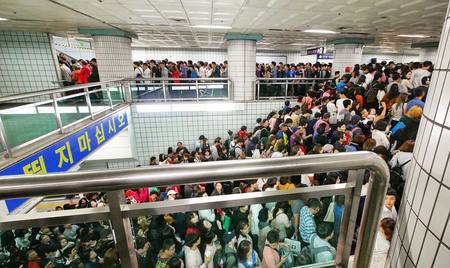
Interesting information for the tourist
The Seoul Metro is the ideal means of transportation so that tourists can visit all of the historical places, as well as other touristic attractions such as theme parks and, eventually, sets and locations where movies are filmed.
Also, the Seoul Metro itself can be considered a touristic attraction. In its busiest stations, there are cultural performances such as free concerts, artwork exhibitions, and collective or individual performances from all kinds of artists. This makes the Seoul Metro a cultural center.
There is another interesting fact that may surprise foreigners, which was something done as a way to compensate the huge investment of money required for the maintenance for the metro system: The Seoul government decided since quite some time ago to sell the names of the stations to private companies and educational institutes within 500 meters from the stations for steep prices. One of the most expensive station names was worth the equivalent of 300,000 dollars, which was bought by the Industrial Bank of South Korea. For example, Bubyeong station has the alternative name written in parentheses of “Catholic University of Incheon”, Sosa station is also called “Seoul’s Theological University”, and Yeoggok station is also called “Catholic University of South Korea”. Such names illustrate the influence that Christianism still has on South Korea.
Seoul Subway map
- Also Known As: Subway
- Passengers/Day 5610000
- Fares: 0.54
- 24h operation: No
- Air Conditioning: Yes
- Walk between platforms: Yes
- Driverless trains: No
- Screen Doors Platforms: Lines 2 and 9, planned for all lines by 2010
- 1
- Seoul Metro Official Website
Help us
If you consider that the information we provide is wrong, not accurated, outdated, translation contains errors, and you would like to help us to improve the file...you can contact us here.
Feel free to contact us if you dont find the system you're looking for and we'll add it as soon as we can!
Thank you very much!







